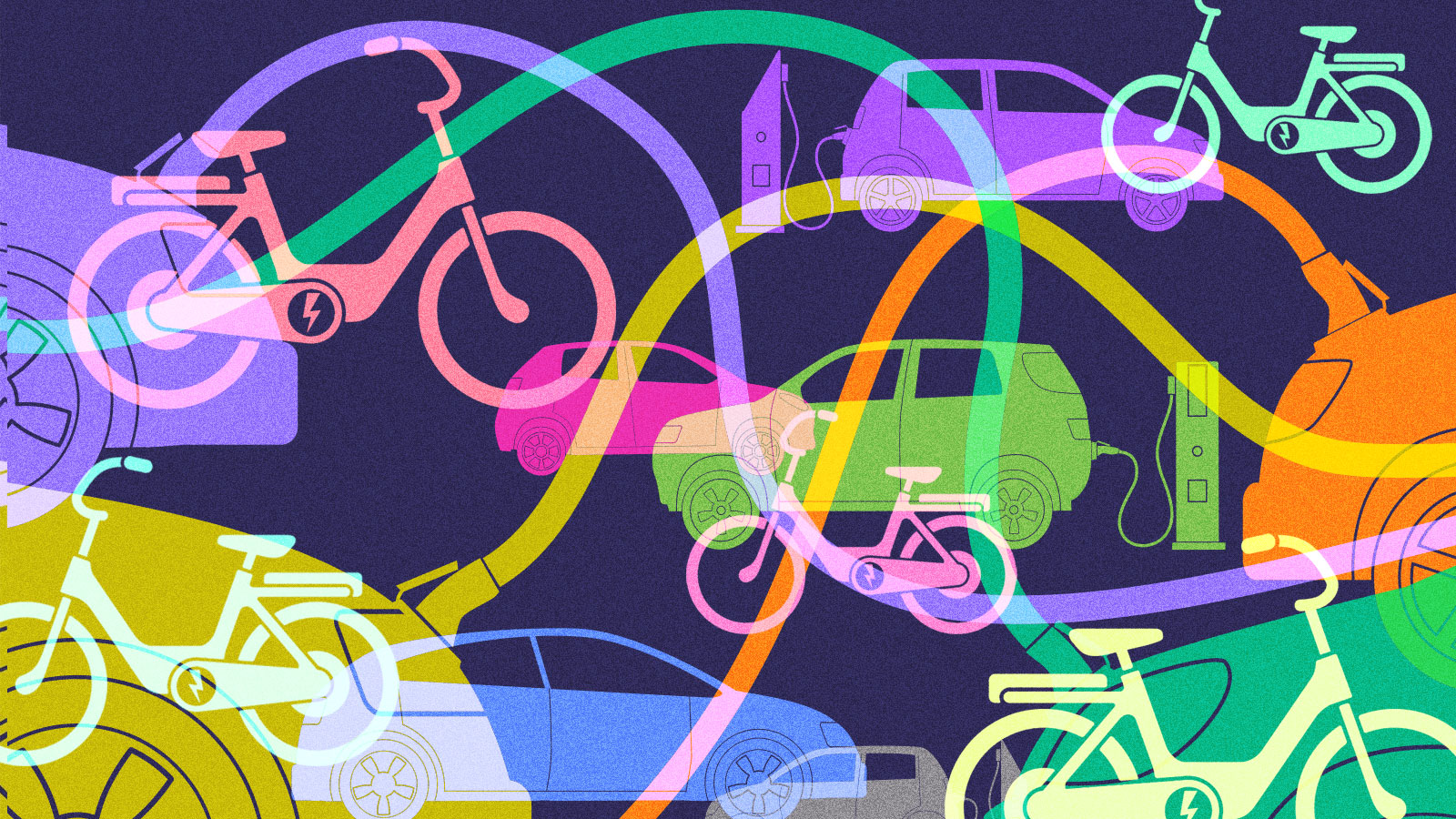This post has been updated to reflect Amply’s funding amount in April ($13.2 million).
Public transportation looks far less appealing with COVID-19 in the mix — April in particular was a dismal month for the country’s largest metro system, with New York City ridership down over 90 percent, and over 130 MTA worker fatalities associated with the disease.
And yet, importantly for the transportation sector, our understanding of the novel coronavirus is still evolving. The Centers for Disease Control and Prevention recently changed their COVID transportation stance to be more transit- and planet-friendly, after originally recommending workplaces use incentives such as “offering reimbursement for parking for commuting to work alone or single-occupancy rides.” And there are other reasons driving may not be the best way to stay healthy. For one thing, parking in dense urban areas and navigating convoluted regulations is no picnic. Also, the emissions associated with driving contribute to climate change and community pollution — both major public-health concerns in their own right.
But even while much of life remains in suspended animation, support for climate-friendly transportation is chugging along. For example, Ford just announced a pledge to become carbon neutral by 2050, California recently mandated that manufacturers only sell electric trucks within the state by 2045, and House Democrats just unveiled their climate plan — which includes a vision for 100 percent clean vehicles by 2035.
Is the promise of a greener transit sector enough to keep cities (and people) going in this public health and transit crisis? We took that question to the experts and asked five Grist Fixers for their takes on the future of transportation post-COVID.
The following responses have been edited for clarity and length.
Communities need data to tailor their transit solutions

Davida Herzl: Co-founder and CEO of Aclima, San Francisco
Reflecting on COVID-19 and the protection of public health and long-term resilience, it’s important to understand how factors like transportation impact air pollution. As things open up, there’s a chance we’ll see significantly increased pollution. People may be less willing to take public transport and so will drive more. If people are working from home and ordering more things online, we may see communities closest to inland ports get exposed to higher levels of black carbon, due to an increase in shipping activity.
In the short term, there’s a whole grab-bag of things that can help. In the U.K. for example, officials have discussed staggering commute times with road-space rationing to reduce transportation-related emissions. And city and state governments can work with large companies to create incentives for work-from-home schedules. But pollution is actually hyperlocal, and it can vary a lot block by block. Communities need data to diagnose where problems are and which interventions could have the highest impact.
At Aclima, we’ve developed a methodology to measure and analyze air pollutants and greenhouse gases so that you can get an understanding of what’s happening both at your address and also at the full regional scale. That data can help us understand where those emissions are coming from, and also whom it’s affecting. For example, in West Oakland in the San Francisco Bay Area, our data is being used to inform a local community emissions reduction plan, looking at everything from electrification to investment in vegetation and natural infrastructure to filtration in schools.
Over the long term, investment in electrification is essential for the transportation sector. Post-COVID, There will be a new “normal” and new patterns of engagement with our urban environment, where we’re not waking up and getting in the car for hours to commute to work. That could work in favor of electrification. If you are mostly making short trips within a community, the pressure on electrification is lower because there isn’t that range anxiety. So we’re looking at things like multimodal transport, bikes, and scooters.
The big takeaway is that transportation solutions aren’t just about climate; they’re about public health and economic resilience. We need a healthy public in order to have a healthy economy, and so we really need to start thinking about emissions reductions through that lens.
One of the biggest transit speed bumps? City budget shortfalls.

Jeanalee Obergfell: City planning associate, Los Angeles
Unfortunately, our Metro numbers have taken a big hit with COVID-19. Both rail and bus line numbers were down in the month of May. But you also see a lot more people on bikes. We’ve had a big fight with increasing bike infrastructure, like putting in more bike lanes. There’s a lot more that needs to be done, but like many cities, Los Angeles is looking at a very scary budget situation. Basically, anything nonessential in the next budget year, which starts in July, is going to get cut. It’s pretty dire. And, unfortunately, a lot of the sustainability and green stuff is considered nonessential. That includes a lot of much-needed infrastructure. They’re even talking about cutting basic services like tree trimming.
Before COVID, we had a lot of targets to change most of our fleet to electric vehicles. Much of the police force adopted EVs, and the fire department was starting to do the same. A lot of the EV bus budget, including EV charging stations, got cut from next year’s budget. And then the mayor only has one more year left. If we’re still in the budget crisis for the 2021–2022 year, what happens with our sustainability plans will really depend on who wins the next mayoral race.
It’s pretty bleak at this moment, but I think L.A. has overcome plenty of bleak moments. New challenges always come along with opportunities to grow and learn. Once we get through the “groan zone” — that’s a conflict-resolution term that refers to the point during a decision-making process when everyone is tired of it and just wants to give up — we can come up with solutions that work. And I am actually excited for what can happen and what change will come from all of this.
In certain metros, transit innovation is still very much alive

Chris Castro: Director of sustainability and resilience for the city of Orlando
I truly believe that, even with COVID, Orlando is going to be moving more toward a greener future. COVID is a respiratory illness at its core, and it’s showing how communities of color have been disproportionately impacted by poor air quality throughout the country. It’s underscoring the importance of clean mobility and the need for us to transition rapidly away from fossil-fuel internal combustion engines to electric vehicles.
The economic outlook is certainly uncertain. We’ve seen transit stations in Orange County drop about 64 percent in terms of use. We’ve waived transit fees during this time of COVID-19, but we can’t afford to do that for much longer. But I’m encouraged, because our local leadership understands the importance of decarbonization — Orlando was the most visited city in America the last three years, with over 75 million visitors in 2019, and around half the congestion we face is from tourism. So, from a finance perspective, we’ve actually developed some really creative ways to accelerate this process. The city of Orlando owns our own electric and water utility, and we’ve been able to leverage on-bill financing as a means of accelerating EV charging infrastructure.
We’ve really been focusing on what we call ACES, which stands for “autonomous, connected, electric, and shared” mobility, positioning Orlando as a test bed for the future of mobility. A few years ago, we created the Central Florida Automated Vehicle Partnership, which includes government at the local and federal levels, NASA, the Kennedy Space Center, quasi-government institutions, and academic institutions like the University of Central Florida. We have a two-and-a-half-mile test track called SunTrax and even a mock “smart city” business district where these vehicles can interact with pedestrians.
We also have a new high-speed rail, Virgin Trains, that will connect Orlando to Miami by the end of 2021. And then we have several micro-mobility solutions, from scooters to bike- and moped-sharing. We also just invested about a million dollars in public EV charging stations. As a result, I think we have one of the most robust EV infrastructures in the country. We also have the only airport electric rental-car program, and that rental acts as a VIP pass at theme parks, with perks like free charging and preferred parking.
We’ve put a lot of resources the last few years into positioning Orlando to be this future-ready city that’s focused on not just transportation mobility, but the green economy, renewable energy, zero-waste solutions, and the like. Our focus on developing autonomous, connected, electric, and shared mobility is critical for our climate strategy and our overall sustainability initiative. It’s also critical for public health, and it’s going to be critical to get through this pandemic, too.
COVID-19 has increased the clamor for clean air

Vic Shao: Founder and CEO of Amply, San Francisco
During the global lockdown over COVID-19, many cities around the world saw clear blue skies for the first time in a long time. People don’t want to give that up. In Milan, they’ve cordoned off large sections of central downtown to vehicles. Research shows that air pollution can make people more vulnerable to COVID-19, and so policymakers and urban planners are starting to see clean air become more of a social-justice issue, too. In short, there’s no going back — both for clean air and economic reasons.
Despite the recent drop in oil prices, electricity is still a cheaper energy source, and it is only going to get less expensive year after year as utilities phase out aging power plants and phase in renewable energy. In an economic downturn where budgets are tight, electric buses are five times cheaper to repair and maintain than vehicles with internal combustion engines, and electric cars are twice as cheap to “refuel.” While consumers may put off buying cars during the economic downturn, fleet operators such as transit buses, shuttles, school buses, and delivery trucks will stay the course: After a certain age and mileage, it makes more sense to buy new rather than fix the old. We may also see electrification ramp up because certain markets like airport shuttles and university shuttles could choose to skip intermediary technologies — going straight from diesel-powered fleets to EVs rather than using a stepping-stone technology like compressed natural gas.
Sure, there could be some short-term challenges in the marketplace, but here at Amply, which offers EV fleet charging services, our investors are eyeing the long run. We closed on $13.2 million in funding in April, kind of at the height of all this. It’s completely nuts. I think it speaks to the strength and the opportunity in electrification. Seventy-five percent of Amply’s customer base is in the public sector — transit, agencies, schools, and so forth. These entities aren’t about to go out of business any time soon.
Cities need to stop ignoring the role of equity in transportation

Courtney Williams: Chief strategist at The Brown Bike Girl, Brooklyn
We are in a state of emergency because of COVID. And when you’re in a state of emergency, that means you do nontraditional things. You have the liberty to implement resources and override things. And residents of Black and brown neighborhoods are the ones who are traveling the farthest and are most dependent on the most dangerous forms of transportation. Unless we really take serious steps to accommodate what they are calling the “bike boom,” we’re going to end up with problems. You need to teach people how to not only choose and physically ride the bike, but also how to navigate a traffic environment.
I was invited to participate in Mayor Bill de Blasio’s Surface Transportation Reopening Committee for biking, pedestrians, and public space. We’re supposed to come up with recommendations for how the city should manage its streets. We need to reclaim lanes from car traffic, we need to make lanes wider and create biking infrastructure that’s inviting to the public. I also think cities need to take more assertive stances on educating car owners and recognizing that this new mix of transportation vehicles — like bicyclists and micro-mobility users — is their priority, because when car operators understand that the city enforcement is going to protect cyclists and micro-mobility users, they’re more apt to respect them.
But the committee has not made use of us as experts. There’s this thing that happens as a person of color and a person talking about equity. People always hear you, they acknowledge that what you said was great and pivotal, and then they don’t do anything.
One of the equity issues with bike shares is that stations are frequently located in white, affluent areas. It’s primarily Black and brown neighborhoods that don’t have bikes, so it becomes a perk of whiteness to be able to be physically healthy. During COVID, Citi Bike created a program where they were going to help essential workers get to work by giving them free memberships. But at the same time, bike shares are only available in certain areas, and the most fundamental part of accessing a bike is that it is physically located near your home.
Bikes are also important vehicles of protest in this moment. If you want to show up to a bike protest, you need to start digging into policies and think critically about what you have and what you love about your bike. Non-Black allies then zoom out and ask, do Black people have the same freedom of experience that I have? And if the answer is no, those are the areas you should dedicate yourself to, because there’s going to be a time when all of this very visible adrenaline-pumping action dies down. That won’t mean that it’s over.



